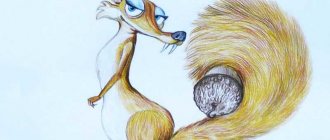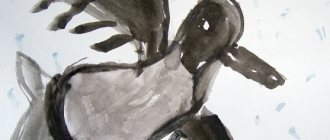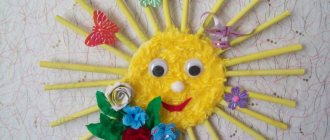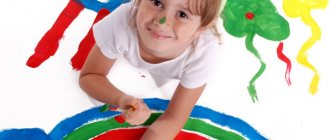Sea sunset in oil painting
Just yesterday you were enjoying the sea view, and today there is a snowy blizzard outside the window. It comes to your mind to depict an unforgettable sunset on the sea, and do it in oil to surprise your guests. It is worth noting that this is quite difficult for beginners. Experts strongly recommend attending special courses where you will be taught step-by-step lessons in oil painting. This is the best option for those who want to seriously engage in creating works of art on their own.
Sunny light watercolor
You have repeatedly stopped near paintings of seascapes done in watercolors. The depicted ocean breeze filled you with inspiration and a passionate desire to try your hand at painting yourself. We offer a lesson containing specific steps to achieve the goal.
What is needed to create a beautiful landscape in watercolor:
- paper with a semi-smooth texture (use a small sheet to start);
- round brushes - No. 12 is the largest brush, No. 8 is medium-sized and No. 4 is the smallest brush;
- watercolor paints of recommended shades (they will be indicated during the proposed master class), they can be replaced with paints of your choice.
Let's start drawing
- The first step is to create a sketch. We draw the contours with a simple pencil and should be barely noticeable on paper.
- The second step is drawing the sky. We thoroughly wet the paper above the horizon line and give it time to soak it. Take a large brush and apply a few very light strokes using yellow paint. This is how we designate the clouds in the sky. The color of cobalt blue will be used to highlight the upper silhouettes of the clouds. We rinse the brush well and use it (let it be a little damp) to blur the outlines, in this way achieving fusion in the color scheme. Then we will continue to paint the sky with blue paint, at the same time marking the bottom of the clouds. Without letting the paper dry completely, draw shadows on the clouds. For this we will use blue and red colors.
- The third stage will be the most crucial moment - drawing the sea elements. We use brush No. 12. We apply phthalocyanine blue paint mixed with water on it in quite a large amount. We make the initial strokes using a technique, the essence of which is that the resulting mixture is applied to dry paper with sliding movements of the hand. We work with the whole brush and part of it alternately. Some areas on watercolor (grainy) paper will remain clean. This way we create the appearance of a sparkling expanse of water. On the water (the paper should remain damp) we create a little depth. We make several small strokes with blue and green paints.
- The fourth step will bring you much closer to completing the work. Mix blue and yellow colors and a small drop of red, and draw the silhouettes of the hills located on the edge of the horizon. Here you need to try hard to give the colors a muted hue and the contours blurry. In this way we emphasize the appearance of the remoteness of the hills. We will definitely wait until the area of the sea surface has completely dried and begin to draw water ripples and waves. We make the strokes larger and much richer than the individual details drawn.
- Step five is the final stage. We use brushes of medium size and the smallest in shape. We use them to draw the pencil-drawn outlines of the boat and people. We work with two shades of red paints, mixing them into one. The nuance in this drawing is that you should not thoroughly draw human figures. They will look more natural in a slightly messy image.
The work is completed. However, you can add your own additions, for example, enliven the picture with soaring seagulls.
The provided lesson will help you create a simple marine plot and, perhaps, give inspiration for painting with watercolors.
Amazing sea
- You should start your drawing with a thoughtful definition of the parts of the drawing: the horizon and the coastline in the plot you have planned. On land, sketch out the outlines of small boulders. Be clear about the beach line. If desired, draw a silhouette of the sun, mark the waves around the stone ledges in the sea.
- The next step will be to depict the initial outlines of the waves on the entire sea surface. To do this, make several strokes with a pencil over the entire water surface. However, don’t get carried away – quantity is no substitute for quality. Because in this case it will not be possible to depict fairly large waves.
- Next we move on to drawing and line painting the silhouettes of the waves near the stone figures. This is where you will need to use a specific technique. Pencil marks can be softened using your fingers (rubbing the line drawing with them), or using an eraser with sufficient rigidity. A similar procedure is carried out with part of the sea.
- Now let's move on to the design of the shore. Similar to the procedure with the sea surface, the sandy shore is shaded with pencil strokes and then rubbed. It is also quite possible to lighten dark places in sea areas (if there is such a thing). By intensively shading the stones we will achieve their expressiveness. Sketch the outlines of the clouds.
- This stage is intended to depict the heavenly expanse above the sea. Start by sketching out some small clouds. Faint strokes will emphasize the movement of air. Add a sun to the picture (optional).
A little perseverance and patience will help you cope with this lesson.
Drawing the sea with children
After a holiday at sea, children often want to convey their impressions on paper. Many parents provide paints or gouache to create a sea-themed painting. A master class on depicting the sea in pencil will bring considerable joy to both the baby and his parents. We offer step-by-step drawing of the water element.
- Draw a frame on the sheet using a ruler. In the lower right corner of the upcoming drawing, sketch out a small scalene triangle.
- Draw two strips from the mound upward so that they come closer at the top. This is a palm tree trunk. Draw palm leaves at their junction. And below, at the base of the trunk, add a few more small slides. Subsequently, this area will need to be painted over with a different color.
- Just below the center of the sheet, draw a horizon line. Draw the sea, starting from it. Draw with a pencil. Draw a wavy line from the center of the horizon. This way you will select the area separating the sea from the beach. You don’t have to draw the outline of the sea exactly from the center of the horizon, as your imagination dictates.
- Above the depicted horizon, draw two or three hills (mountains), placing them side by side. Since they are in the background of the picture, you should not paint them large.
- The black and white sketch is ready. Feel free to start coloring the picture with your child. You can leave this process completely in the hands of your son or daughter. For the palm tree, take brown and green pencils. For the bumps, use different shades of green, moving from a darker tone to a lighter color. Color the mountains in the same way. Shade the sea surface with a blue pencil, and closer to the horizon use a dark blue pencil. Some areas of pencil strokes can be slightly softened with a finger or a fairly hard eraser. For the sand on the beach, use a light brown color.
- The completion of the work will be the decoration of the sky with a pale blue tint. Do not paint over the entire sky, leave white cloud areas.
Your child will be proud of the resulting picture both in kindergarten and at school.






